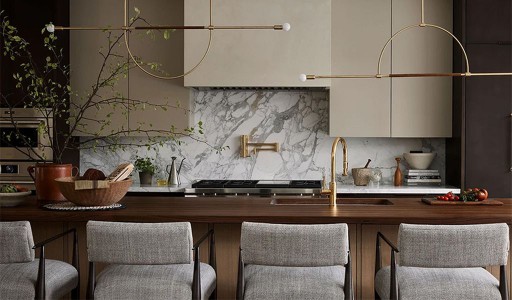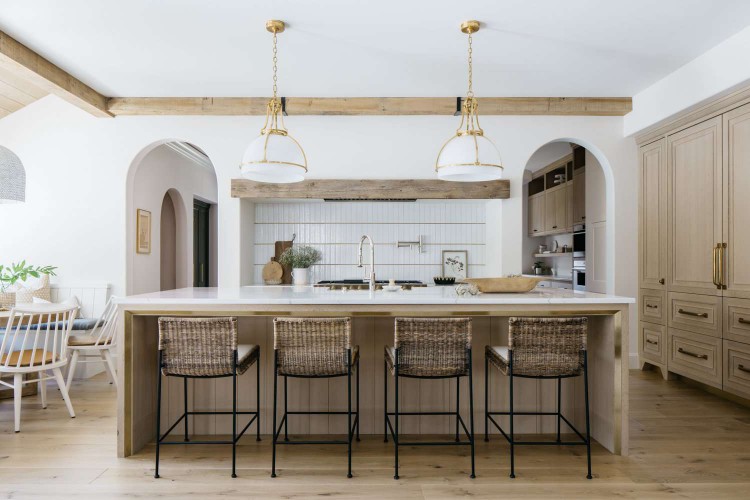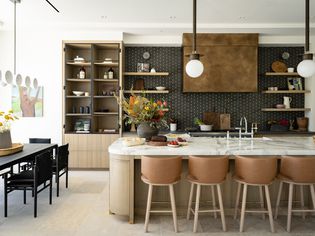Key Takeaways
- Kitchen islands increase functionality by adding more storage, workspace, and entertaining areas.
- Use painters tape to map out the island area on your floor to see how it affects the flow of the room.
- If you don’t have the space for an island, consider adding an elevated lighting plan or additional fridge.
If given the option, a kitchen island feels like a no-brainer. The added space is multi-functional—perfect for entertaining, serving, and prepping, as well as an additional source of storage.
But are kitchen islands a must-have? We consulted a few design pros to get their thoughts, and it turns out the answer isn’t exactly black or white.
Meet the Expert
- Brittny Button is an interior designer and the founder of Button Atelier.
- Kristin Dittmar is an interior designer and the founder of Kristin Dittmar Design.
Are Kitchen Islands Still a Must-Have?

Ashley Montgomery Design
Whether or not your kitchen needs an island depends entirely on the layout of the room and availability of space.
If you don’t currently have an island but are considering adding one, interior designer Brittny Button suggests some major space planning first. Luckily, you can do this by using painter’s tape to map out the ideal dimensions on your kitchen floor.
“Live and see if the movement in the room is enhanced or obstructed before committing,” says Button. “You’ll get a sense of whether it will be valuable.”
Without doing so, you could end up detracting from your kitchen's ease of use and desirability.
“Sometimes I’ve seen builds where they’ve crammed it into the space and it wrecks the flow of the room,” she says.
Luckily, if you're building from scratch you should have a lot more room to play with. Interior designer Kristin Dittmar says that while the size and function should fit the space and lifestyle of the homeowner, she always does her best to prioritize an island.
“Honestly, I can’t remember the last time I designed a kitchen without one,” she says. “They can provide storage, seating, prep space, or even serve as a focal point that ties the whole room together.”
Want more design inspiration? Sign up for our free daily newsletter for the latest decor ideas, designer tips, and more!
More Kitchen Must-Haves

Kate Marker Interiors
Whether you’re dealing with a small space or a tricky layout, Button says a great lighting plan is the real must for any kitchen. Along with overhead lighting, task lighting, and ambiance, Button says you should also maximize any natural exterior light.
But light isn't the only way to bring the outdoors inside. Dittmar says she prioritizes beautiful, practical styling in a kitchen, which includes fresh flowers or a plant to bring life, color, and a touch of nature according to the season.
“In my own kitchen, I always have flowers, and my husband likes to keep a bowl of nuts or snacks out for our family, which makes the [space] feel inviting and lived-in,” she says.
It’s also worth considering that although a kitchen island can be great, it’s really the functional aspects people love. If you can’t fit an island, Button says it’s more important to focus on efficient use of your space, as well as livable storage. Plus, there are other ways to add luxuries aside from an island.
“If possible, have an extra fridge,” Button says. “Even if it’s just for drinks or ‘supplementary food items,’ it makes it way easier than having to run to the store frequently.”
3 Other Home Must-Haves for Buying and Selling

Laura Brophy Interiors
Of course, what you put in your home will ultimately depend on whether you find it worth adding or not. However, there are a few things that increase function and desirability, which is important if you're buying or considering selling down the line.
Cohesion Between Rooms
As Button points out, one thing that’s often lacking from homes is a feeling of cohesion between spaces.
When done well, all the rooms in a home should feel connected—not necessarily physically, but through common elements. This can be done through both architectural changes and design choices.
“Arched doorways add real height and a design element,” she says.
Usability and Flow
Because the kitchen is a functional space, Dittmar says she always prioritizes the usability and flow of the space in her design plan.
“A kitchen has to function beautifully before anything else—after that, we can always make it pretty,” she says.
This extends to the rest of the home. Everything should have its place, and the layout should support how your family uses your home.
“When a kitchen is designed with good flow, it makes cooking more enjoyable and also helps keep a busy family running smoothly," Dittmar says.
A Fresh Coat of Paint and Simple Touches
If you’re looking for a low-lift way to give your home a facelift, Dittmar recommends a fresh coat of paint—especially before listing your home.
“It instantly makes everything feel clean and updated,” she says.
Other helpful small touches include refreshed lighting, hardware, and fixtures, which can make a big difference in the eyes of a potential buyer.
“These small enhancements help a home feel current and cared for, which always appeals to buyers,” Dittmar says.
